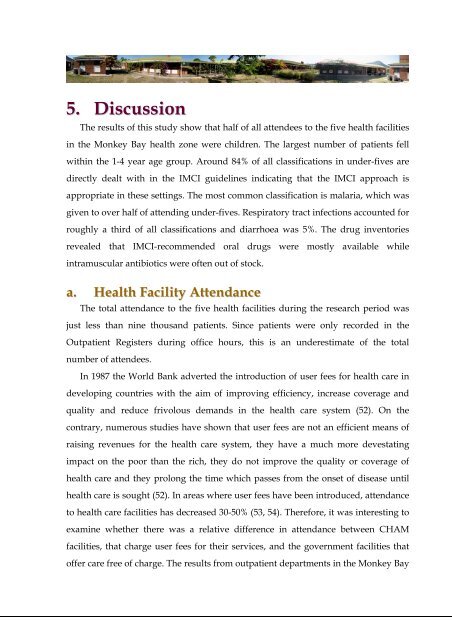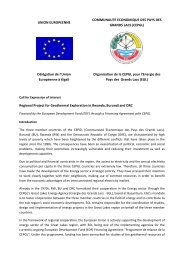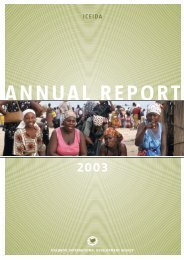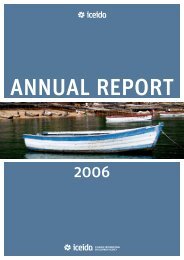The Implementation of Integrated Management of Childhood Illness ...
The Implementation of Integrated Management of Childhood Illness ...
The Implementation of Integrated Management of Childhood Illness ...
You also want an ePaper? Increase the reach of your titles
YUMPU automatically turns print PDFs into web optimized ePapers that Google loves.
5. Discussion<br />
<strong>The</strong> results <strong>of</strong> this study show that half <strong>of</strong> all attendees to the five health facilities<br />
in the Monkey Bay health zone were children. <strong>The</strong> largest number <strong>of</strong> patients fell<br />
within the 1-4 year age group. Around 84% <strong>of</strong> all classifications in under-fives are<br />
directly dealt with in the IMCI guidelines indicating that the IMCI approach is<br />
appropriate in these settings. <strong>The</strong> most common classification is malaria, which was<br />
given to over half <strong>of</strong> attending under-fives. Respiratory tract infections accounted for<br />
roughly a third <strong>of</strong> all classifications and diarrhoea was 5%. <strong>The</strong> drug inventories<br />
revealed that IMCI-recommended oral drugs were mostly available while<br />
intramuscular antibiotics were <strong>of</strong>ten out <strong>of</strong> stock.<br />
a. Health Facility Attendancee<br />
<strong>The</strong> total attendance to the five health facilities during the research period was<br />
just less than nine thousand patients. Since patients were only recorded in the<br />
Outpatient Registers during <strong>of</strong>fice hours, this is an underestimate <strong>of</strong> the total<br />
number <strong>of</strong> attendees.<br />
In 1987 the World Bank adverted the introduction <strong>of</strong> user fees for health care in<br />
developing countries with the aim <strong>of</strong> improving efficiency, increase coverage and<br />
quality and reduce frivolous demands in the health care system (52). On the<br />
contrary, numerous studies have shown that user fees are not an efficient means <strong>of</strong><br />
raising revenues for the health care system, they have a much more devestating<br />
impact on the poor than the rich, they do not improve the quality or coverage <strong>of</strong><br />
health care and they prolong the time which passes from the onset <strong>of</strong> disease until<br />
health care is sought (52). In areas where user fees have been introduced, attendance<br />
to health care facilities has decreased 30-50% (53, 54). <strong>The</strong>refore, it was interesting to<br />
examine whether there was a relative difference in attendance between CHAM<br />
facilities, that charge user fees for their services, and the government facilities that<br />
<strong>of</strong>fer care free <strong>of</strong> charge. <strong>The</strong> results from outpatient departments in the Monkey Bay<br />
41
















